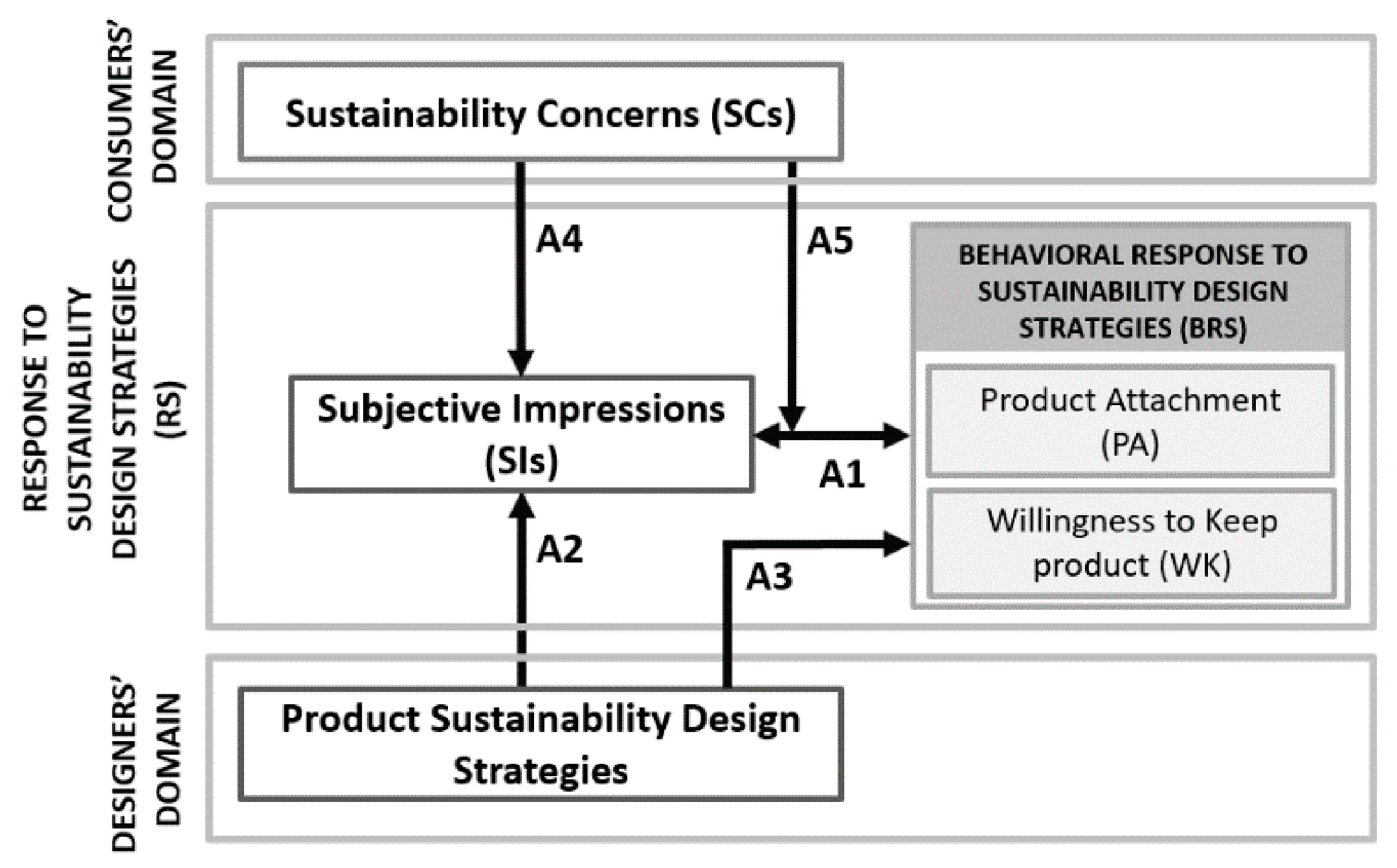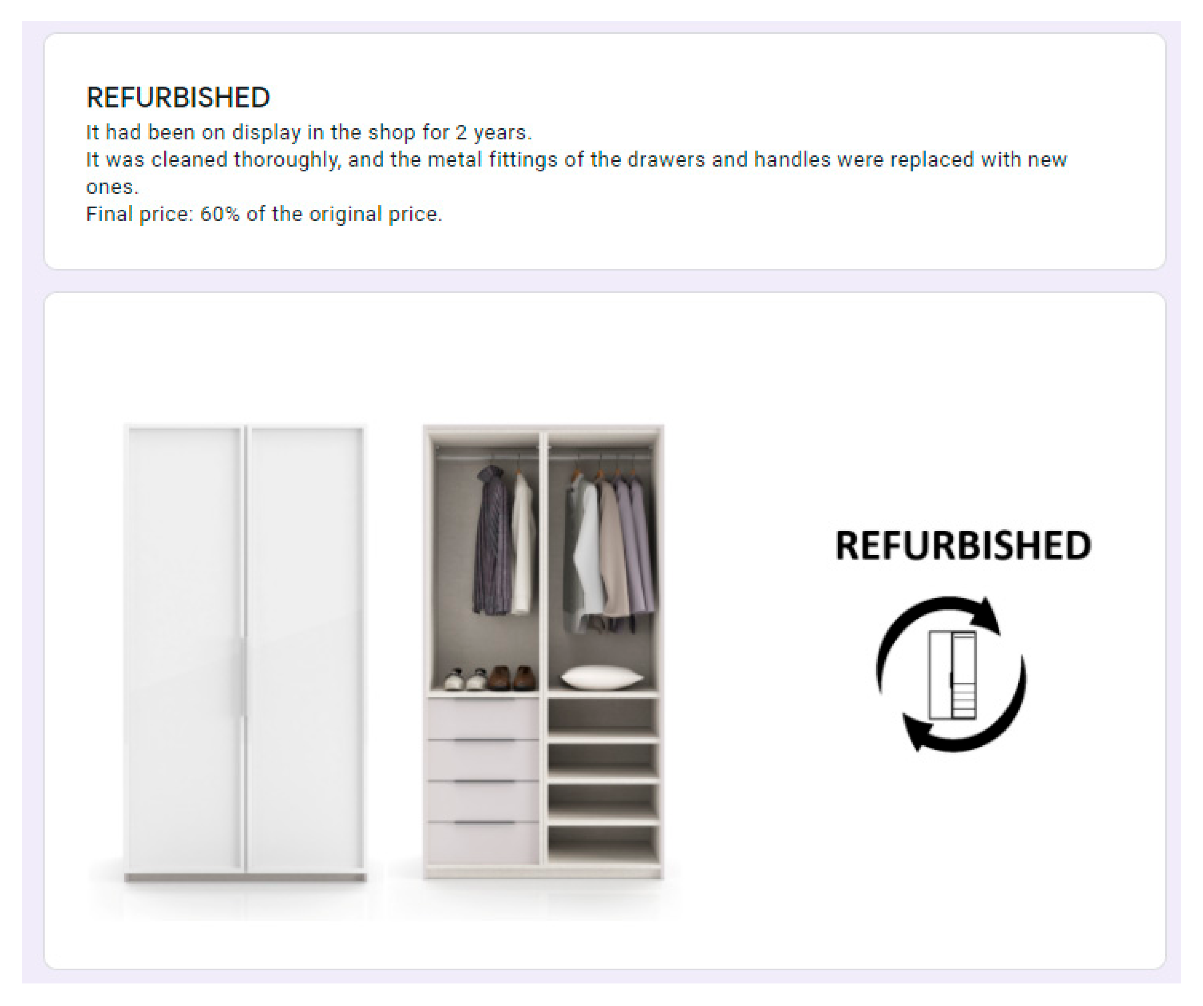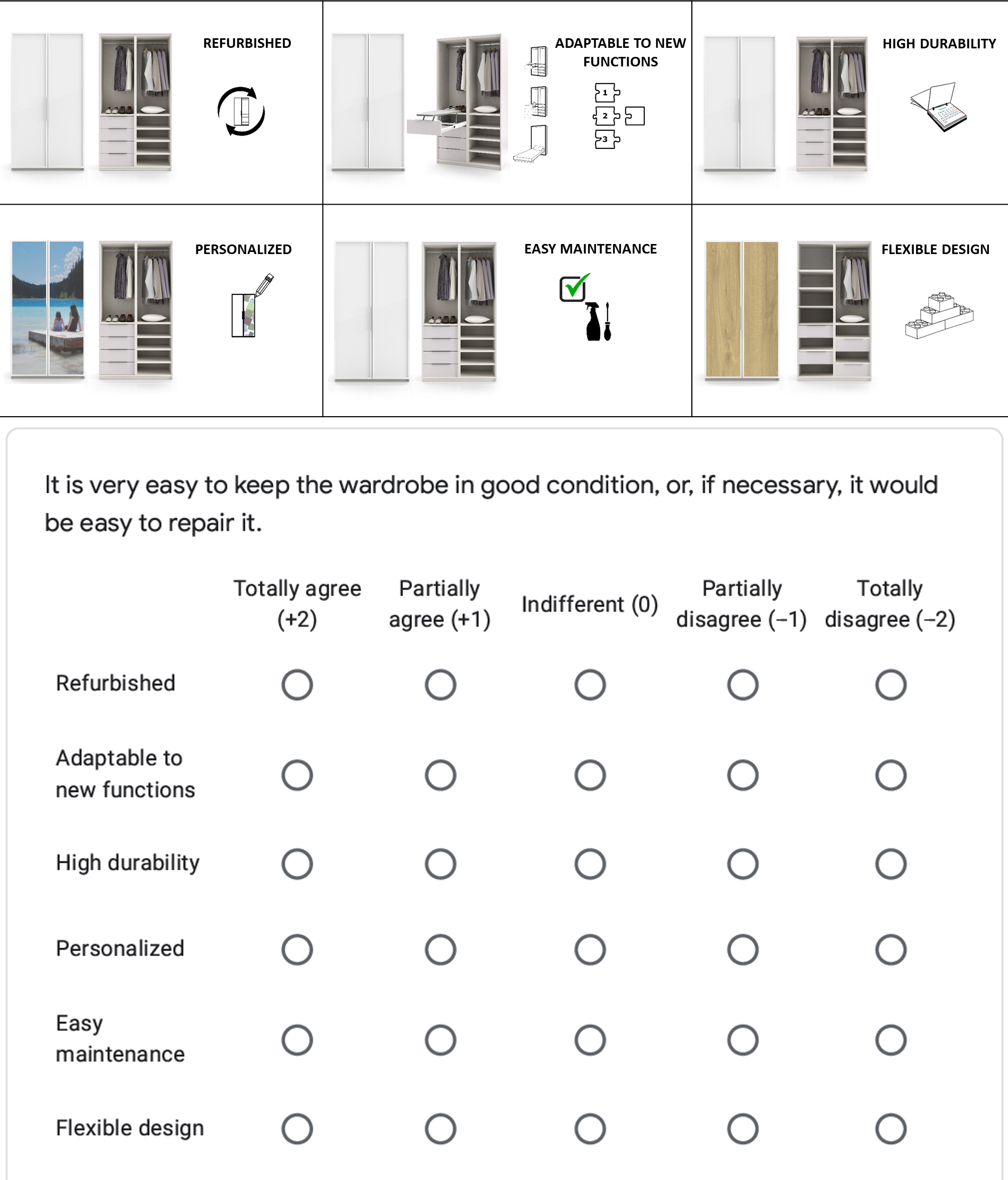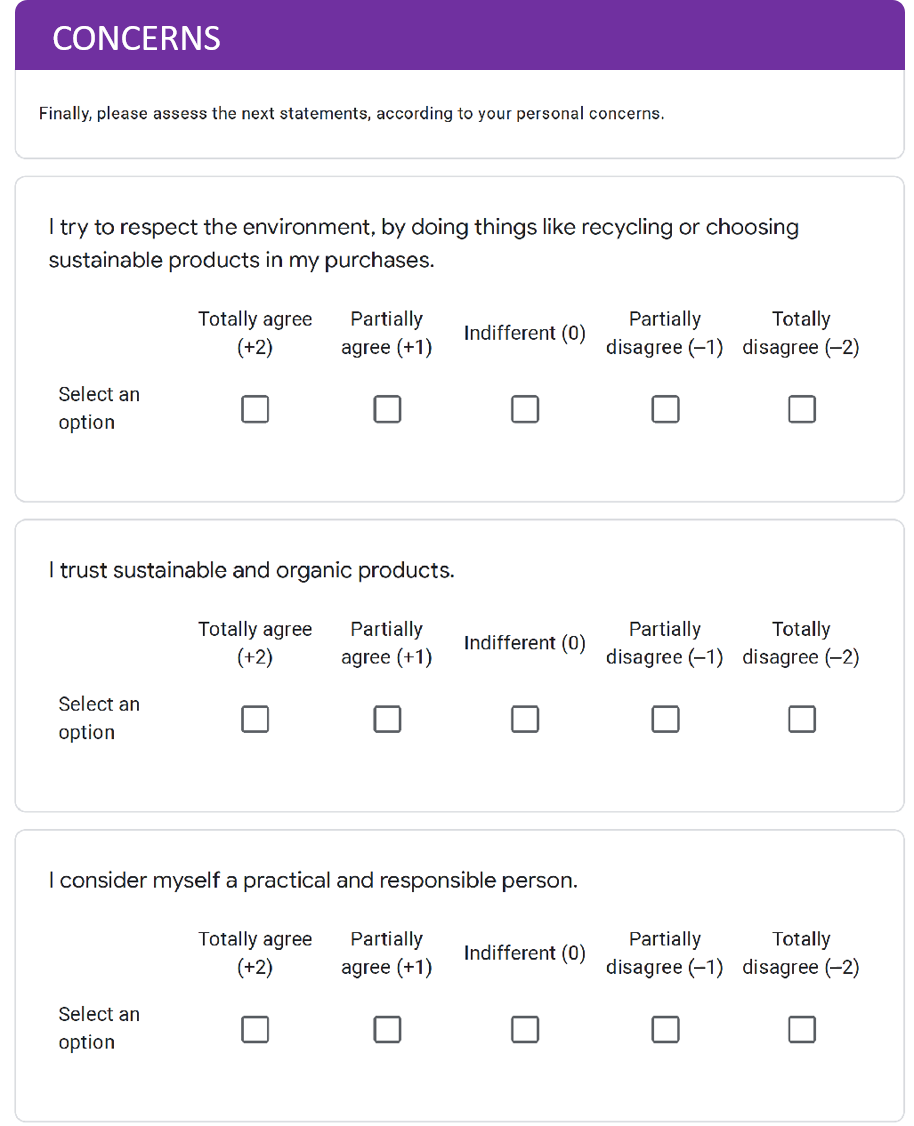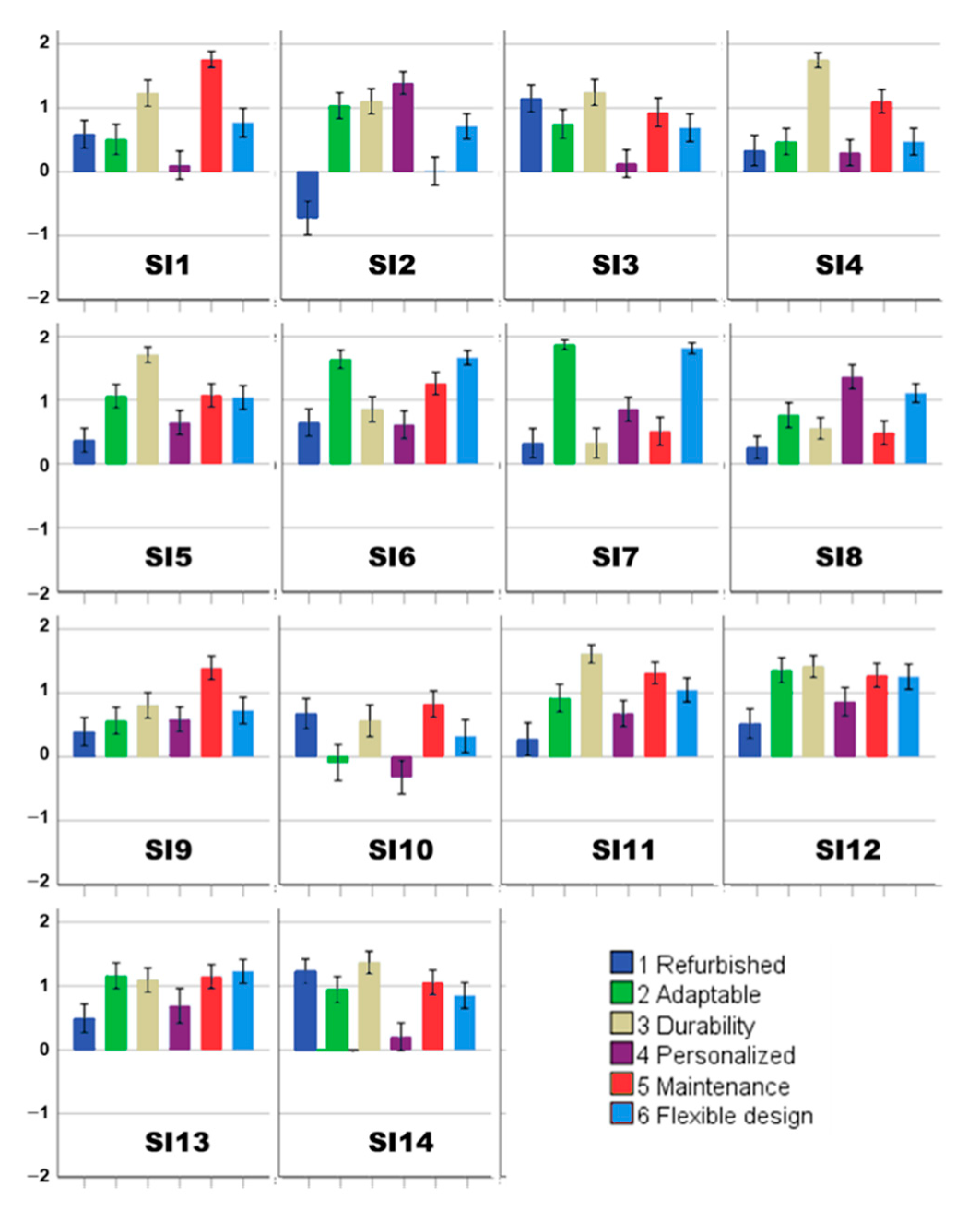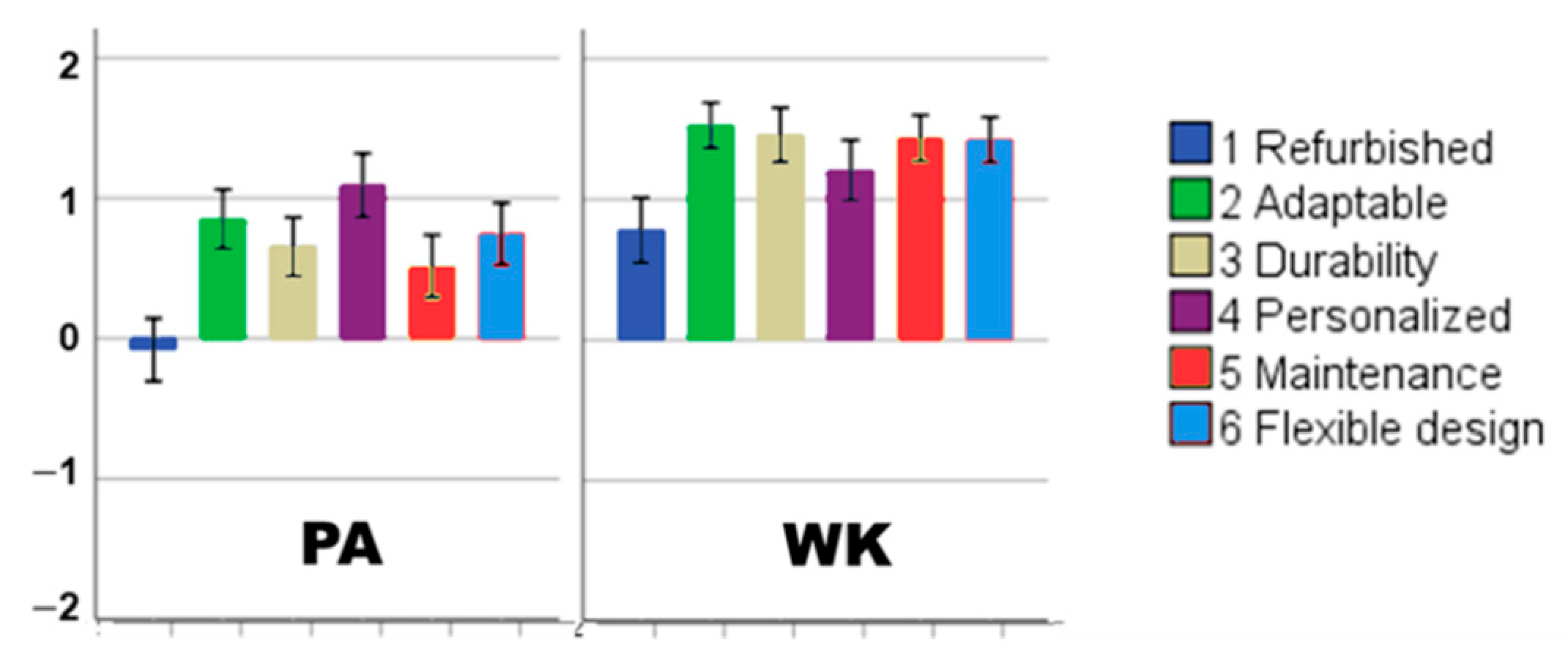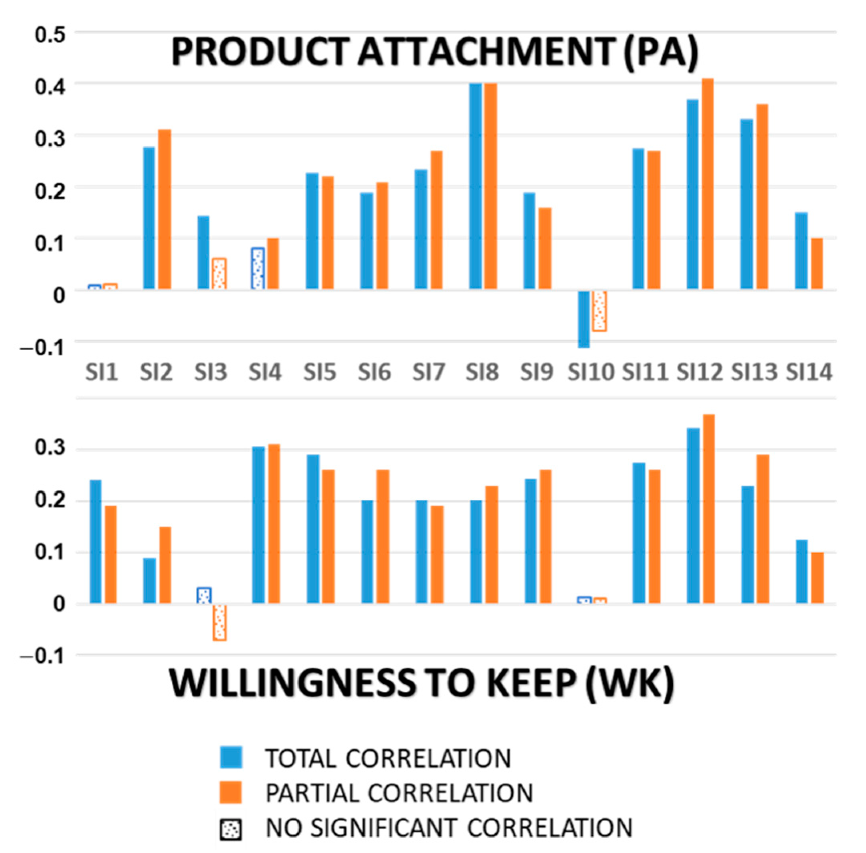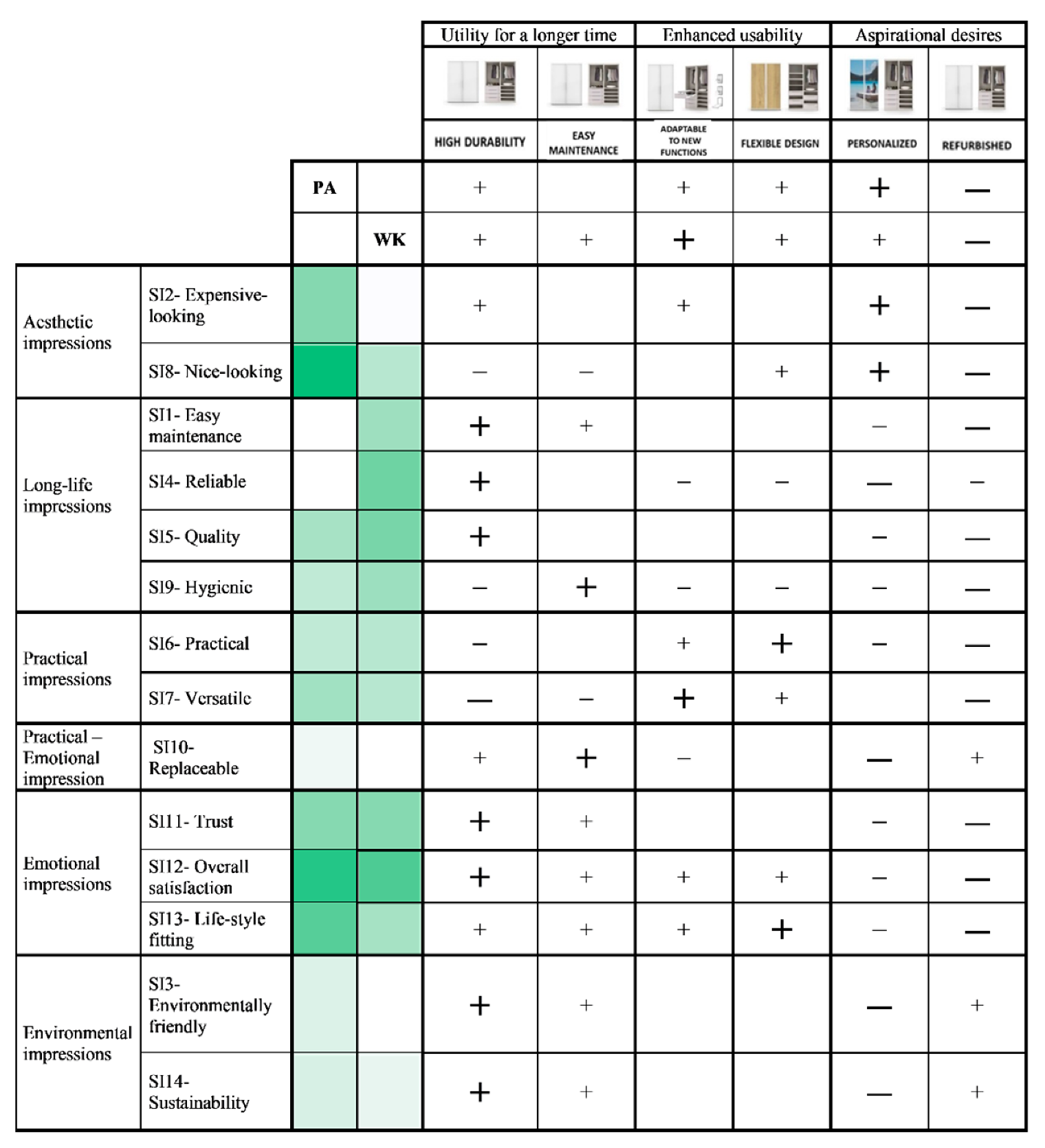1. Introduction
In the field of affective design, it is well known that product design has a communicative function [
1,
2,
3]. In this communication between the individual and the product, the product design elicits different cognitive (meanings) and affective responses (emotions) of different types and intensities [
1,
4,
5,
6], hereafter called subjective impressions. These subjective impressions give rise to a global assessment of the product [
2], product preferences [
7] and behavioral responses [
1,
8]. Therefore, human factors in product design can be used to fulfill users’ needs and wants [
9].
Personal criteria such as sociological reference values or personality traits, resulting from previous experiences, culture, training, and internal and learned rules can also influence consumers’ assessment and behavior [
2,
7]. Consequently, these ‘concerns’ should be considered a possible influence on subjective impressions and product preferences [
10,
11]. All these principles of affective design (subjective impressions, product preferences and behavioral responses), together with personal concerns, can be applied to the environmental and sustainability field.
In recent years, environmental awareness has increased among consumers, who are becoming more and more mindful of the consequences that their actions and purchasing decisions have on the environment [
12]. When selecting certain products, aware consumers apply criteria that go beyond functionality or aesthetics and are more closely related to ensuring a lower impact on the environment.
Some studies have analyzed how a trade-off between sustainability and functionality affects consumers’ choices, with different conclusions: socially responsible consumers promote environmental changes, as their choices can influence the way that products are designed and manufactured [
13,
14]. However, products with a superior functional performance are preferred to those with perceived superior sustainability characteristics [
15]. Some attempts have been made to relate emotions elicited with environmental attitudes and purchase intention in an affective study of green labels, including visual attention [
16], and to relate sustainable design strategies in packaging with behavior, purchase intention, willingness to pay and consumer attitudes [
17,
18]. However, these studies do not consider jointly all of the affective factors influencing these relationships.
Beyond eco-labeling and packaging, and their relationship with the purchase intention, principles of affective design can be applied to the earliest stages to promote and benefit sustainable design [
19] in a wide variety of products, knowing that affect is a potential motivation for consumers to engage in sustainable behavior [
20]. Thus, designers and managers can reduce the environmental impact of their products by understanding consumers’ behavior and orienting them towards more sustainable practices [
21,
22,
23].
One sustainable paradigm currently considered in product design [
24] focuses on development for longevity [
25], encouraging the design of long-life products (by ensuring a long period of product usage) and product life extension (by extending the time that goods can be used through maintenance, repair, etc.). In this context, Chapman [
8] stated that long-life product design is supported by design for attachment and trust (i.e., emotional durability), while van Nes and Cramer [
26] established five design strategies for influencing product lifetime and the replacement decision, namely: design for reliability and robustness, repair and maintenance, upgradability, product attachment and variability. Bocken et al. [
27] differentiated among several circular product design strategies, including: (1) Design for long-life products (i.e., Design for attachment and trust, Design for durability, and Design for reliability) and (2) Design for product life extension (Design for maintenance and repair, Design for upgradability, Design for standardization and compatibility and Design for dis- and reassembly).
Positive emotions can be used to engender environmentally responsible behaviors [
28,
29] and, therefore, affective design might be useful in understanding people’s motivations to adopt the use of sustainable products and continue to use them [
19], and in promoting long-term product involvement. According to affective principles, most of the design strategies presented above are linked to subjective impressions as meanings associated to the product itself (such as robustness or reliability) or emotions elicited in the user (such as trust). However, although product attachment is used repeatedly as a key strategy for long life, it corresponds to a consumer response (a feeling). When people feel attached to an object, they are more likely to handle the product with care and make efforts to keep it in good condition, which results in a longer period of usage [
30,
31]. Therefore, product attachment (related to willingness to keep and take care of it) should be considered as an affective behavioral response of consumers, unlike the treatment given to product attachment as a design strategy in van Nes and Cramer [
26] or Bocken et al. [
27]. In view of the abovementioned elements in this interaction, a conceptual model establishing the relationships among the subjective impressions elicited and consumers’ behavioral responses, sustainable design strategies and consumer concerns is proposed in
Figure 1, based on [
1,
2,
7].
Within the response to sustainability design strategies (RS), subjective impressions (SIs) refer to meanings given to the product and the emotions or feelings experienced by the consumer. SIs related to sustainability aspects are, for example, the consumers’ perception that a product is eco-friendly (meaning) or that they are being more respectful to the environment while using it (emotion/feeling). The behavioral response refers to the final consumer’s behavior, which can be to approach (e.g., buying) or to avoid the product. From a sustainability point of view, the behavioral response to sustainability design strategies (BRS) should include consumers’ responses that are more related to sustainability aspects, such as product attachment (PA) and willingness to keep and take care of it (WK). PA is considered to be the degree to which the individual feels attached to the product, usually due to affective and subjective reasons, and denotes preference. PA can lead to WK, which is more related to an action than to a feeling.
Therefore, in reference to the consumers’ response, the conceptual model in
Figure 1 distinguishes between subjective impressions and behavioral response, so it is possible to delve a little deeper into the relationship between the two components (A1). For the same subjective impression, consumers’ behavioral response may be different, depending on their concerns (A5). Thus, for example, if a product is perceived as expensive-looking, some luxury-seeking consumers may feel attracted to it, while others may consider the product too ostentatious and reject it. Hence, sustainability concerns (SCs), i.e., the degree to which consumers are concerned with sustainability aspects, such as their trust in sustainable and organic products, are also considered to be an influencing factor. Concerns may also directly influence the generation of subjective impressions (A4). For example, a person with environmental concerns may perceive a backpack made from recycled plastic bottles as respectful and nice-looking, while someone without these concerns might consider it extravagant. Therefore, it is possible to distinguish between the influence of personal concerns on the generation of subjective impressions (A4), and on the relationship between those and the behavioral response (A5). From the designers’ domain, sustainability design strategies (design for long-life products and product life extension) influence the subjective impressions elicited (A1). Due to the relationship between these subjective impressions and the behavioral response (A2), sustainability design strategies are also expected to influence consumers’ behavioral response (A3).
Some isolated relations among the elements in the model have already been analyzed, as the influence of some sustainability design strategies on certain factors of consumers’ response, such as users’ emotions, attitudes, consumer behavior or decision making [
8,
26,
27,
32,
33,
34,
35,
36]. Some of the influences of consumers’ sustainability values and concerns on their response have also been studied [
37,
38,
39]. However, in some cases no distinction is drawn between types of response, and the mediating effect of subjective impressions on the final behavioral response is not considered, so these studies do not fully consider the relationships in the model.
The use of affect as a driver to behavior towards sustainability has not been given much attention in literature [
20]. To the best of our knowledge, no study has focused on exploring, as a whole, all the affective relationships among all the factors at play in the interaction between the consumer and a sustainable product design. This is the first attempt at showing the relationship of design strategies for sustainability, emotions and environmental attitudes, within a thoroughly model in the affective domain.
In an attempt to fill this gap, this paper uses a conceptual model based on the principles of affective design (
Figure 1) that allows us to analyze the relationships between design strategies for sustainability and the customers’ response by explicitly considering the mediating effects of subjective impressions (A3 as A2 + A1) and sustainability concerns of customers (A5). The aim of this paper is to explore these relationships in greater depth, in order to gain some insights into the influence of sustainability design strategies on consumers’ response, based on their personal concerns. As a final goal, it is expected that this information will allow designers and managers to improve the strategic characterization and positioning of their products, based on their target consumers, to achieve product life extension.
Section 2 shows the case study developed in order to collect data of all the elements in the model.
Section 3 shows the statistical analyses performed to evidence all the relationships in the model. The results of the study are reported and discussed afterwards in
Section 4 and
Section 5, respectively.
3. Analysis of Results
All of the statistical analyses were performed with the SPSS statistical software (IBM SPSS Statistics 23 for Windows, IBM Corporation, New York, NY, USA).
First, the relationship between the SIs and the BRS (PA and WK) (A1 in
Figure 1) was analyzed applying correlations. Spearman’s rho correlation coefficient was used, as the normality of variables assumption is violated.
Next, differences in the assessments in SIs and the BRS between the six design versions were analyzed (relationships A2 and A3). To verify the influence of the sustainability design strategies on the assessment of the SIs and the BRS, 16 analyses of variance (ANOVAs) were performed. The ratings for the 14 SIs, together with PA and WK, were considered as dependent variables, and the wardrobe version was taken as the independent one. Games-Howell post-hoc comparisons were applied for Levene critical levels lower than 0.05. Otherwise, Bonferroni post-hoc comparisons were used.
To analyze the influence of the SCs on the assessment of the SIs (A4 in
Figure 1), ANOVAs were also applied. However, as the SCs were not selected and collected as factors for the experiment, dummy variables (DSCs) were generated from the ratings of SCs to distinguish two groups in each SC. The DSCs adopted a value of 1 when the rating of the original SCs was a positive number (1 or 2), and 0 otherwise. For the ANOVAs, the ratings for the SIs were considered dependent variables, and the DSC was taken as the independent one.
In order to determine the influence of SCs on the relationship between SIs and the BRS (A5), partial correlations were applied between SIs and PA, and between SIs and WK, controlling for the effect of the SCs. Partial correlations determine the lineal relation between two variables, removing the possible effect of a third variable.
4. Results
The questionnaire was answered by 87 participants (52.9% women, age: 23% under 25, 51.7% between 26 and 45, 23% from 46 to 65, and 2.3% aged over 65).
Table 5 presents bivariate correlations between the SIs and the BRS (relationship A1 in
Figure 1). All the SIs presented a significant positive correlation with PA except for SI1 and SI4 (which presented no significant correlation), and SI10 (which maintained a significant negative correlation). The subjective impressions that were most correlated with PA were aesthetic impressions (SI8 Nice-looking; S2 Expensive-looking) and emotions (SI12 Overall satisfaction; SI13 Lifestyle fitting; SI11 Trust). The weakest correlations (lower values of the coefficients) were found with the SIs linked to the environment and sustainability (SI3 Environmentally friendly; SI14 Sustainability). No significant correlation was detected with the impressions SI1 Easy maintenance and SI4 Reliable, both related to achieving a long use of the product.
With regard to WK, all the SIs maintained a significant positive correlation with it, except SI3 and SI10. The most correlated impressions were linked to impressions related to achieving a long use of the product, such as SI4 Reliable, SI5 Quality, and SI1 Easy maintenance, and to emotions, such as SI12 Overall satisfaction, SI11 Trust and SI13 Lifestyle fitting. Again, the SIs linked to sustainability and environment maintained weaker correlations (SI14) or no significant correlation (SI3).
Figure 5 shows bar graphs with mean values and 95% confidence intervals for the means of the assessments of the six design versions, for each SI. The ANOVAs showed statistical differences in all SIs between some of the versions (
Table 6). High durability (version 3) and Easy maintenance (version 5), corresponding to strategies for achieving a longer use of the product, were the best rated in SIs about long-life products and product life extension (SI1 Easy maintenance, SI4 Reliable or SI9 Hygienic), as expected, and also regarding trust in the purchase (SI11). The High durability version was also the best rated in SI5 (Quality). The strategies for achieving a varied use of the product, i.e., Adaptable to new functions (version 2) and Flexible design (version 6), were the best rated in ‘functional and flexible’ SIs, such as Practical (SI6) and Versatility (SI7). The Personalized version (version 4) was assessed as being nicer (SI8), more expensive-looking (SI2) and harder to replace (SI10), but unsustainable (SI14), not very respectful with the environment (SI3), and difficult to maintain (SI1). The Refurbished version (version 1) obtained comparatively lower assessments in aspects such as expensive-looking (SI2), high quality (SI5) or trust in the purchase (SI11), and higher ratings in respect for the environment (SI3) or sustainability (SI14).
Figure 6 shows mean values and 95% confidence intervals for the means of the assessments of both BRS for the six design versions. The ANOVAs showed statistical differences for both assessments between version 1 (Refurbished) and all the others. In the case of PA, there was also a significant difference between versions 4 (Personalized) and 5 (Easy maintenance) (
Table 6).
Table 7 shows descriptive statistics for the SCs. The sustainability concerns most valued by the participants were: SC7, related to keeping some special products; SC3, referring to personal practicality and responsibility; SC6, which refers to the willingness to maintain and repair personal belongings; and SC1, referring to respect for the environment. The last column shows the frequency (percentage) of values of the dummy variable DSC with high values for each SC.
Figure 7 shows the mean ratings of the SIs, for each DSC.
Table 8 shows significant differences found in the ANOVAs with DSC as a factor for each SI. Colored cells are the cases where significant differences were detected. Even though the distribution of cases between the different levels of the DSCs is quite unbalanced for some SCs (especially for DSC3 and DSC7), some differences were nevertheless found.
Figure 8 shows the values of the full and partial correlation coefficients of the SIs with PA and WK, in order to check the effect of the SCs on this relationship (A5). The greatest change in the coefficient appeared for SI3 (Environmentally friendly), which was not significantly correlated with PA when sustainability criteria were not considered. In addition, some changes were observed in both PA and WK for SI12 (Overall satisfaction) and SI13 (Life-style fitting), and in WK for SI1 (Easy maintenance), SI2 (Expensive-looking) and SI6 (Practical).
5. Discussion
It is known that product design characteristics and personal values and concerns both influence consumers’ response [
16]. In the field of sustainability, some studies about these influences have already been carried out to favor the desirability of purchasing a product [
16,
17,
49], or to promote sustainable behavior [
20,
50]. A sustainable paradigm related to product design [
24] encourages the extension of product life and its use time. In this sense, affective design can contribute to promote these goals [
9,
19,
51]. However, affective design models in the literature consider and distinguish among relationships that occur in the user–product interaction to a greater degree. Thus, within the consumers’ response, it is possible to distinguish between the subjective impressions generated (which include both the meanings referring to the product and the emotions elicited in the individual) and the behavioral response; that is, the affect towards it, or the reactions of approaching the product or avoiding it [
1]. Although the relationship between both components of the response has been demonstrated in the general affective field [
7], for the topic of sustainability, this distinction has not been studied in as much detail. Furthermore, this analysis will make it possible to go deeper into the influence of design strategies and personal concerns in the consumers’ response.
With this idea in mind, this paper provides a novelty, as it proposes a comprehensive model about consumer–product interactions while considering the relationships produced between the subjective impressions generated and the behavioral response from a sustainability point of view. The influence of factors from the designers’ domain (i.e., strategies for sustainable design) and from the consumers’ domain (sustainability concerns) on the consumers’ response are also considered.
Previous works have not delved in such detail into the study of the affective relationships between these factors. Some models in the literature have analyzed the mediation effect of affect between cognition and behavior, focused on purchasing intention [
51], while in this work, the study of behavior has focused on the post-purchase phase, and is referred to factors that favor a long product life, distinguishing between attachment and willingness to keep.
Specifically, six versions of a wardrobe were defined to reflect different sustainability design strategies [
26,
27], which were classified according to their aim [
9,
41]: achieving product utility for a longer time, enhancing product usability over time and targeting aspirational desires. Seven concerns, mainly personal values and criteria related to sustainability, were also considered. Consumers’ response was represented by 14 subjective impressions related to product long-life, functionality, aesthetics and environment, and by two product-related behavioral responses to the sustainability strategies (product attachment and willingness to keep).
Figure 9 summarizes the relationships obtained between the subjective impressions and the behavioral responses (relationship A1 of the model). The intensity of the shaded cells in the third and fourth columns represents the strength of the correlation. Additionally, for each design strategy, the highest and lowest ratings for PA, WK and SIs have been indicated with positive or negative signs, respectively (relations A3 and A2).
There is a strong correlation between the subjective impressions and consumers’ behavioral responses (relationship A1 in the model in
Figure 1): 11 (out of 14) SIs were significantly correlated with PA, and 12 in the case of WK (
Figure 9, shaded columns). Aesthetic impressions are the most related to PA, in line with Schifferstein and Zwartkruis–Pelgrim [
30], who suggested that product enjoyment is a driver of attachment, which contains the aesthetic pleasure derived from a beautiful appearance, among other aspects. Furthermore, long-life impressions are more correlated with WK and emotional impressions are strongly correlated with both behavioral responses. Practical impressions are also (although not so strongly) correlated with both behavioral responses. Conversely, environmental impressions have obtained low or non-existent correlations with the BRS. This raises a reflection about the idea, mentioned in the introduction, that consumers apply criteria that go beyond functionality or aesthetics and are more closely related to ensuring a lower impact on the environment, which does not seem to be supported by these results. In contrast, our results are in line with Luchs et al. [
15], who claimed that only beyond a certain threshold of functional performance achieved are other aspects more closely related to aspirational desires valued, the aesthetic one having a high value in the final choice.
Sustainability design strategies influence consumers’ behavioral responses, through their relationship with the subjective impressions (relationships A3 and A2). The versions with strategies related to achieving product utility for a longer time (High durability and Easy maintenance) are positively assessed on most impressions, mainly on emotional and long-life ones, which in turn are more related to WK, leading to the highest assessments in WK. These strategies, oriented toward longer performance, are better assessed than those seeking aspirational desires (Personalized and Refurbished). This agrees with the results of Luchs et al. [
15], who found that consumers prefer a product perceived as superior in functional performance rather than superior in sustainability characteristics.
The versions with strategies for enhanced product usability (Adaptive to new functions and Flexible design) are also related to WK, and at the same time they maintain a higher relation to PA. These versions have a particular influence on the assessment of the practical impressions, and also on the emotional ones, which in turn maintain strong correlations with both PA and WK. Our results agree with those of Hata et al. [
52], who concluded that modular design increases the chance of reuse. If a product is based on a modular design, replacing some parts or even cleaning it will be easier, which could lead consumers to keep it for longer.
The versions corresponding to strategies aimed at aspirational desires (Personalized and Refurbished) show quite different results. The personalized version has the highest influence on aesthetic impressions, which are highly related to PA. In fact, this version is the best assessed for PA. However, although the aesthetic characteristics (especially SI8, Nice-looking, strongly correlated to PA) have managed to increase the perception of PA, the perception of the rest of the impressions has low assessments compared to other versions. Results for emotional impressions stand out: the versions for utility and usability have obtained better assessments on trust, satisfaction and lifestyle-fitting than the personalized version, which could be related to the high functional load of the product chosen in the study. Further research would be needed in order to confirm that the relationship between emotions and certain product meanings varies depending on the type of product, since this result does not correspond to the idea that personalization is a design factor that stimulates emotional bonding with the product [
53], at least for the product used in this application (wardrobes). However, despite the strong correlation of emotional impressions with PA, the Personalized version obtained the best assessment in PA, above that of the versions for utility and usability. This is an interesting result, as it highlights the idea that perceived positive aesthetic qualities influence the acceptance of a design, or the perception of other product characteristics, such as usability or performance, in accordance with other works [
10,
54,
55].
The Refurbished version was the one with the worst assessment on both PA and WK, and on most subjective impressions. It only presents positive ratings on the environmental and the replaceable impressions. Therefore, even though wardrobes have been previously chosen as a product category that would potentially accept refurbishment [
56], other strategies are better accepted by consumers to increase PA and WK. Mugge et al. [
40] verified that, although participants showed a positive attitude towards refurbished smartphones, most of the highest scoring incentives underlying the purchase were product-related. Therefore, perceived environmental benefits should be studied depending on the customers and also on the product.
The results described up to this point indicate that the consumers’ response can be influenced by factors from the designers’ domain, through the design strategy, as they affect subjective impressions, which are related to the behavioral response. Long-life impressions are more linked to WK, while aesthetical impressions are more related to PA, and practical and especially emotional impressions are linked to both WK and PA. From a sustainable approach, managers and designers should consider that in order to achieve a greater consumer willingness to take care of the product and give it a long useful life, the most appropriate strategies are those related to utility and usability. However, the highest levels in both behavioral responses (PA and WK) are not achieved at the same time; PA increases as the product is provided with possibilities allowing it to change, such as flexibility and adaptability, reaching its maximum value for product personalization. As designers obviously desire a product response that achieves a high degree of attachment, it will be necessary to consider other characteristics, in addition to those related to utility and usability. Thus, although the consideration of functional characteristics is an adequate strategy to achieve long-life products, incorporating modular, versatile and aesthetical characteristics into sustainable products can help to achieve greater consumer engagement. This engagement is even more relevant, considering that the environmental impressions maintain weaker or inexistent correlations with PA and WK. In fact, the Refurbished version, with high assessments on the environmental impressions, had poor assessments in almost all the other impressions.
However, it is worth noting the effect of sustainability concerns on consumers’ subjective impressions and on their relationship with the behavioral responses (relationships A4 and A5 in the model in
Figure 1). Thus, for example, consumers who define themselves as ‘used to quality’ rated the impressions Expensive-looking and Hygienic significantly higher than the rest, while those who define themselves as environmentally respectful rated these impressions with significantly lower ratings than those who are not especially concerned about the environment. Those who said they like to repair rated the impressions Environmentally friendly and Sustainability significantly higher than the rest. Furthermore, the previously mentioned correlation between the impression Environmentally friendly and PA disappears if the effect of sustainability concerns is not considered. Designers should therefore also consider whether the designed product is addressed to a particularly aware type of consumers, in order to weigh up the functional, versatile and aesthetic characteristics that should shape the product [
2,
7].
Although principles of affective human-factors design have previously been applied to sustainability [
20,
49,
50], the distinctions made in this work between types of consumer responses (subjective impressions and behavior), between behavioral responses (product attachment and willingness to keep it) and their relationships with consumers’ concerns have made it possible to offer managers and designers interesting results regarding how to generate sustainable responses in consumers. Therefore, by knowing what factors influence certain types of consumers to have a greater attachment and willingness to keep, designers can create the most appropriate products, based on the customer profile and their concerns.
The influence of any design strategy on the consumers’ behavior (relationship A3 in the Introduction section) should be analyzed in two phases. One phase should consider their effect on the subjective impressions elicited (relationship A2 in the model proposed in
Figure 1) and the other phase should consider the relation (A1 in the model) of these subjective impressions with the behavioral response (in this work measured as attachment and willingness to keep the product). Our results are an example illustrating the importance of distinguishing between subjective impressions elicited and behavioral response: in order to reduce the environmental impact of a product by means of a high attachment to it, the subjective impressions that should be generated are not those related to the environmental aspect, as could be expected, but rather the emotional, aesthetical and practical impressions.
The relationship between subjective impressions and behavioral response (A1 in our model) is expected to be more stable than its relationship with the design strategies (A2). The elicitation of subjective impressions from a product design could change over time, due to factors such as fashion or technology. For example, a black product could be perceived as modern or classic, depending on the current fashion, whereas individuals’ preference for products that are modern or classic is usually more stable over time. Of course, the personal situation of each consumer also exerts an influence, and so concerns should also be considered (relationships A4 and A5 in our model).
It is also worth noting the distinction made between different behavioral responses, which, to our knowledge, has not previously been studied in the literature. Although the results obtained show that most subjective impressions are related to both product attachment and willingness to keep, some cases in which only one of the behavioral responses was related have been identified. This result provides encouragement to keep on studying the types of behavioral responses that can be favored by meanings and emotions generated by product design.
The study has been applied to wardrobes, and it is expected that specific results of the study (such as how a specific strategy as refurbishment affects the behavioral response, or how a specific concern influences the consumers’ response) are also applicable to types of products that can trigger similar affective relationships (such as furniture, lamps, domestic appliances), as there is evidence from previous works that the acceptance of some strategies depends on the type of product [
56]. However, other types of products could present other specific relationships. For example, the fact that the utility and usability versions have a more positive influence on the emotional impressions than those of the personalized one could be a specific result for this type of products that could not appear in products more subjected to fashion changes such as glasses, for instance. Further work should study sustainability strategies for other types of products, or even services, as, for instance, hotels or restaurants, offering sustainable services.
Some limitations in the study must be highlighted. Participants self-reported their sustainability concerns and assessed SIs, PA and WK for the six versions of a wardrobe, but these assessments could differ from real concerns and behaviors. The study considers product attachment as a potential bond that a consumer could have with a product. The authors are aware that emotional attachment includes a previous experience with objects. However, in this research consumers should imagine a hypothetical situation and interaction with a wardrobe. Moreover, perceptions are focused on the first interaction between the individual and the wardrobe, and emotional reactions could change over time [
57]. Replicating the experience with another specific sample balanced on each SC level would be interesting to validate results, as this was not considered in this work. Finally, socio-economic variables could be analyzed in order to examine their influence on affective design principles for improving product attachment and willingness to keep.
